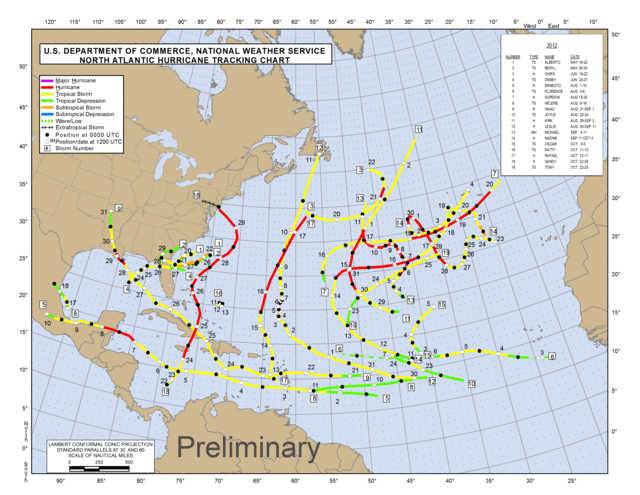https://www.youtube.com/embed/dmLYjs0kwncThe 2012 Atlantic Hurricane Season in 4 minutes and 28 seconds. Video: NOAA Visualization Lab
Today marks the end of the , one of the busiest and costliest storm seasons in U.S. history. This season tied 2010 and 2011 for third place all time with 19 named storms, making the three-year span a rare, extended period of high activity.
In 2012, there were named storms, 10 of which became hurricanes and one of
which became a major hurricane. NOAA classified the year as “above normal” based on the number, intensity, and duration of all tropical storms and hurricanes, saying that 10 seasons exceeded 2012 in the last three decades in terms of the combined effect of the three previously mentioned factors. The only major hurricane of the year was
Michael, a Category III storm that died out over the Atlantic Ocean, but the storm that people will talk about when they
mention 2012 is, of course, Sandy.
“This year proved
that it’s wrong to think that only major hurricanes can ruin lives and impact
local economies,” , acting director of NOAA’s National
Weather Service. “We are hopeful that after the 2012 hurricane season, more
families and businesses all along the Atlantic and Gulf Coasts become more
‘weather ready’ by understanding the risks associated with living near the
���Dz����ٱ����Ա�.”

Sandy graded as high as a Category II storm in the
Caribbean. She jabbed Jamaica and sent high winds and heavy downpour into Haiti before delivering a knockout punch to New Jersey and New York—and then barreling inland and sending high winds, rain, and snow rippling out over the Eastern U.S.
Analysis of the 2012 Atlantic hurricane season shows that it extends two major trends. The first trend is another year with a higher than average number of storms. There has been an increased cluster of storm activity that began in
1995—since then, 70 percent of seasons have had an above normal count. An average season
has 12 named storms. The 19 named storms of 2012 make it one of the top five
seasons since records have been kept in 1851. The previous two
years, 2010 and 2011, also had 19 named storms. In other words, three of the top five seasons
for sheer number of storms have occurred in the last three years. The only two seasons with more than 19
reported storms occurred in 2005 (28) and 1933 (20), according to Jeff Masters of . Masters said
that database is biased—some early storms may have been missed because of
primitive technologies—but that the three most recent seasons would
still make a list of the top 10 busiest Atlantic storm seasons after factoring in undercounting before 2002.
The second trend shows a dry spell in major hurricanes hitting the coast. While Sandy proved that a hurricane doesn’t have to be major—Category III, IV, or V—to do loads of damage, this year there was no major hurricane that
made landfall. As Brian McNoldy of the said, it has been 2,592 days since the last major
hurricane, Hurricane Wilma in October 24, 2005, hit the U.S. coast. That’s the
longest stretch that a major hurricane hasn’t made landfall since
1900—eclipsing the previous record by almost a year and counting. This year, a
persistent jet stream over the eastern part of the country helped steer many
storms away from the coast, but such a drought can’t last forever.
Here are some other interesting stats from the 2012 Atlantic
Hurricane season, by the numbers:
320, $70,000,000,000: Estimated fatalities and cost of
eight of the most memorable storms of 2012 so far, respectively. “,” Brian McNoldy
253, $63,000,000,000: Estimated fatalities and cost of
Sandy so far, making it the second costliest
hurricane in U.S. history behind Katrina’s $128 billion mess, respectively. “,” Brian McNoldy
1 IN 5,800 YEARS: Chance of having three consecutive
seasons with 19 named storms after factoring in possible missed storms prior to
2002. “,”
Dr. Jeff Masters
1 IN 157 YEARS: Chance of having three consecutive
seasons with 12 named storms that last for more than two days each—another feat
achieved by the 2010, 2011, and 2012 storm seasons. “That's
a pretty rare event, and it is possible that climate change, combined with the
fact we are in an active hurricane period that began in 1995, contributed to
this rare event,” wrote Dr. Jeff Masters in “.”
2: Hurricanes that formed in the tropics. Eight other
hurricanes formed above 22 degrees north latitude. “,” Brian McNoldy
7: Consecutive years that no major hurricane—Category III, IV, or V—has hit the United States coast. “,” NOAA
25-40: Period of time high-activity Atlantic storm eras have
lasted in the past. The current trend for higher than normal storm counts began
in 1995. “,” NOAA
—Joe Spring